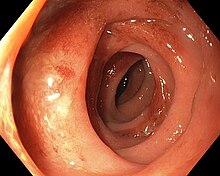| Segmental colitis associated with diverticulosis | |
|---|---|
| Other names | SCAD |
 | |
| Endoscopic image of segmental colitis associated with diverticulosis, Type A | |
| Specialty | Gastroenterology |
| Symptoms | Rectal bleeding, Abdominal cramping, Asymptomatic |
| Usual onset | 64 years of age |
| Types | A-D |
| Diagnostic method | Colonoscopy |
| Differential diagnosis | Bacterial colitis, Diverticulitis, NSAID-induced colitis, Crohn's disease, Ulcerative colitis |
| Treatment | Antibiotics, Mesalamine, Prednisone, Surgery |
| Prognosis | Benign |
| Frequency | 0.3 - 1.3% |
Segmental colitis associated with diverticulosis (SCAD) is a condition characterized by localized inflammation in the colon, which spares the rectum and is associated with multiple sac-like protrusions or pouches in the wall of the colon (diverticulosis). Unlike diverticulitis, SCAD involves inflammation of the colon between diverticula (interdiverticular mucosa), while sparing the diverticular orifices. SCAD may lead to abdominal pain, especially in the left lower quadrant, intermittent rectal bleeding and chronic diarrhea.[1]
The cause of SCAD is unknown, but may be related to local colonic ischemia, fecal stasis, or mucosal prolapse. The factors that cause SCAD likely overlap with inflammatory bowel disease. There are four types of SCAD, which are categorized based on the appearance during colonoscopy. Pattern A is characterized by involvement of crescentic folds and is the most common type of SCAD (52%).[2] Pattern B has an appearance similar to mild-to moderate ulcerative colitis (30.40%), whereas pattern C appears similar to Crohn's disease (10.90%).[2] Pattern D is the least common, and appears similar to severe ulcerative colitis (6.50%).[2]
SCAD is diagnosed by colonoscopy. Additional testing may be necessary to rule out infectious causes of colitis. Evaluation should include assessment for additional causes of colitis, such as medication induced (checkpoint inhibitors, NSAIDs, etc.). Laboratory results are usually normal in SCAD, although the white blood cell count may be mildly elevated. Fecal calprotectin, a marker of colon inflammation, may be elevated. Computed tomography of the abdomen is not routinely necessary, but may show thickening or inflammation in the distal colon (sigmoid colon) with associated diverticulosis.
Treatment may consist of antibiotics, aminosalicylates (mesalamine), or prednisone. In rare cases, surgery with segmental resection may be considered. The long term prognosis is likely benign, although data is lacking. The prevalence of SCAD ranges from 0.3 - 1.3 percent.